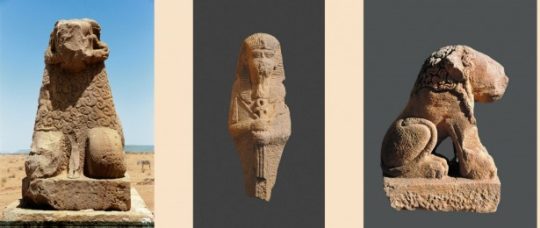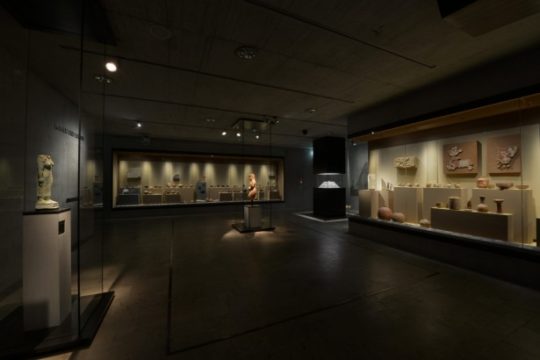Art in Naga
For almost two millennia, the ancient city has remained undisturbed neither by subsequent settlement nor by excavations nor artefact robbery. Suffering only the deterioration brought upon by natural forces, Naga offers, under the rubble and sand, the archaeologist an intact site, its monuments and small finds still in place. For example, when clearing the Temple of Amun, statues and stelas were recovered from their original position. These undisturbed deposits are ideal for revealing information on dating and the functional relationships between the objects.
Sculpture
An alley of 12 figures of rams has be re-erected before the Temple of Amun. Small statues of King Natakamani in the regalia of the god Khonsu originally stood before their chests.
As a cult centre to the lion god Apedemak, Naga possesses many lion statues, originally set up at the ramps in front of the temple façades. The statues of gods and kings offer a wide spectrum of African, Egyptian and Hellenistic stylistic features.
 © Naga-Projekt
© Naga-ProjektArchitecture, Relief, Painting
These three spheres of influence also shaped temple architecture, as well as the reliefs and paintings on the temple walls and their altars and stelae. Egyptian principles of form merge with the more corpulent African vision of beauty, attired in Hellenistic garments and hairstyles. The art of Naga serves as an excellent demonstration of how the Meroitic culture served as a bridge between Africa and the mediterranean world.
 © Naga-Projekt
© Naga-ProjektThe finds displayed in the special exhibition ROYAL CITY OF NAGA, which toured in Munich (2011) and Berlin (2012), present an art-history overview of the heyday of the Kingdom of Meroe, in the 1st century AD.
Items on Loan
Thanks to the National Corporation for Antiquities and Museums Khartoum (the Sudanese antiquities administration), it is possible for a selection of finds from the Naga excavations to be displayed in the Egyptian Museum in Munich, in an exhibition hall dedicated exclusively to “Nubia and Sudan”. Among the loans are for example, the
Isis, the stela of Queen Amanishakheto, as well as a painted stucco fragment of a wall paintingt from the Temple of Amun in Naga.
Flyers and info material in the exhibition rooms inform the public of our commitment to the Sudan. It is definitely worth a trip!
 © SMÄK, Marianne Franke
© SMÄK, Marianne Franke
